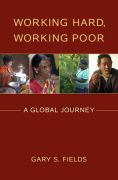
More than three billion people in the world live on less than two-and-a-halfU.S. dollars per person per day. In this book, Gary Fields explains how the poor work, how they have improved their self-employment earning opportunities, how poor-country governments can stimulate more inclusive economic growth, andhow they can be aided. More than three billion people, nearly half of humankind, live on less than two-and-a-half U.S. dollars per person per day. Studies have shown repeatedly that the main and often the sole asset of the poor is their labor. It follows that to understand global poverty one must understand labor markets and labor earnings in the developing world. Excellent books exist on ending world poverty that discuss in depth many important aspects of economic development but do not focus onemployment and self-employment, work and non-work. Working Hard, Working Poorfills in where the other books leave off. Issues of analyzing poverty and low earnings in the developing world are quite different from those in the developed world. The discourse in the developedworld is about incentive effects of social welfare programs, cultures of poverty, single-parenthood, homelessness, drug and alcohol abuse, ill health, mental illness, domestic violence, and the like. But in the developing world, different issues predominate, such as own-account work and household enterprises, agricultural work, casualemployment, and informal work. And some of the policy issues--stimulating economic growth, harnessing the energies of the private sector, increasing paid employment, and raising the returns to self-employment--take a different twist.This book shows how people in poverty work, what has been effective inhelping the poor earn their way out of poverty, and how readers might help. AcknowledgmentsPart I: How the Poorer Half WorksChapter One: A Life's JourneyChapter Two: A Problem of Enormous ProportionsChapter Three: Four Workers' StoriesChapter Four: How the Poor Are WorkingChapter Five: Labor Markets in a Globalized WorldPart II: Helping the Poor Earn Their Way Out of PovertyChapter Six: Setting Objectives, Facing TradeoffsChapter Seven: Growth, Trade, and AidChapter Eight: Harnessing the Energies of Private CompaniesChapter Nine: Labor Market Policies for Generating More Wage EmploymentChapter Ten: Increasing Self-Employment EarningsPart III: Taking ActionChapter Eleven: What Can You Do?ReferencesIndex
- ISBN: 978-0-19-979464-5
- Editorial: Oxford University
- Encuadernacion: Cartoné
- Páginas: 240
- Fecha Publicación: 05/01/2012
- Nº Volúmenes: 1
- Idioma: Inglés
